Kinocene Ethics
Thomas Nail
Thomas Nail's Theory of the Earth, recently published with Stanford University Press, forms the capstone of his six-volume series on the philosophy of movement. Whereas the previous volumes offered a wide-ranging theory of matter in motion in Western and Near Eastern thought and history, from Lucretius to Marx, Theory of the Earth embeds this work in a deeper material history of the cosmos, here interpreted through “kinetic patterns of diffusion evolving with everything else in the universe.” Nail invites us to imagine a reciprocal transformation of philosophy and cosmology: on the one hand, philosophy appears at once as a material and cosmic activity, one among many profligate techniques of kinetic expenditure; at the same time, the cosmos itself becomes, in a deeper sense, philosophical — that is, “capable of philosophy.”
Naturally, such a transformation would first require that philosophy (but also science, politics, and the arts) abandon many of the Western fictions it has tenaciously guarded at its center. Chief among these is the belief in a stable and predictable earth — a dangerous and culpable illusion that, according to Nail, lies at the root of "all contemporary global crises." This presupposition of stability and stasis underwrites the triumphalist self-understanding of Western civilization as a “progressive realization of fixed forms,” a narrative that has justified the domination of man over nature, form over matter, domestication over migration and nomadism, and so on. By eliding the primacy of motion and expenditure, the architecture of progress and development has reaped wanton destruction across the globe. Only today, confronted by a dramatically unruly and tumultuous planet, are we finally forced to confront the arrogant blindness of this posture.
Among the many striking provocations that accompany Nail’s materialist cosmology of motion, we find a new attack on “conservationist” approaches to ecological crisis. As its title suggests, "Kinocene Ethics" (the final chapter of Theory of the Earth) proposes a profound ethical recalibration based on an overturning of the relation between life and death. From a kinetic point of view, Nail argues, “life is capable of vastly more expenditure if it is allowed to live out its death and help the rest of the earth to do the same.” When taken to its conclusions, this insight leads to a new practical centrality of death over life, at the same time as it signals a transvaluation of both terms: “Life is no longer about accumulation and preservation, but expenditure, and death is no longer an end state, but the process of expenditure itself.” The result is a new ethical and political crossroads: “We can either become what we are (expending animals), or we can act as if our purpose is to conserve, accumulate, and instrumentalize life. The latter tends to produce extinction, the former to extend life.” If we hope to outlive the nightmare of capitalist society, perhaps we must first learn to die well.
—Ill Will, April 2022
Part of our series Worlds Apart, exploring cosmology, ecology, science fiction, and the ends of capitalist society.
[My aim in Theory of the Earth is to introduce a] shift in perspective…from a theory of a static or stable earth, viewed through the narrow lens of human history in the Holocene, to a much more mobile and experimental earth, tending toward patterns of optimal kinetic dissipation.
The earth is not a passive object or stage for human activity, nor is it a benevolent subjective agent of life (Gaia). If anything, the earth is a process of expenditure and death — more like Python than Gaia.
Human animals do not live on the earth. They are the earth. Technically, even the earth itself is not of the earth. It is a branch of a massive cosmic dendritic flow, of which humans are one tiny experimental capillary seeking out optimal kinetic expenditure into the cool darkness of space. The duration of our life on this planet is related to how well we help our planet and the cosmos expend itself. The biosphere has tried five different capillary paths so far, each ending in mass extinction — like river tributaries that dried out in the sun before making it to the ocean, or the tentatively stepped leaders of a lightning strike abandoned for another direction.
There is a double meaning to the Kinocene. On the one hand, it is a planetary epoch defined by the increasing geological mobility of various strata in broader circulation than ever before. However, despite this burst of temporary mobility for some parts of the planet, the Kinocene has led to a net decrease in total planetary expenditure and mobility. This is because it has destroyed much of the most efficient dissipative system on the planet: the biosphere. I call this tendency “Kinocene extinction.”
On the other hand, the Kinocene is also the geological epoch in which climate change has forced us to confront our entanglement in cosmic energy expenditure. The Kinocene could, therefore, be the epoch in which global humanity actually rediscovers its place in the energetic nature of things.
Human animals are not at the top of a cosmic hierarchy, but at the bottom of a river delta. We are not unique in our ability to help or hinder the optimal expenditure of matter in motion, but we are distinct in our capacity, at the current historical juncture, to correct an error in our own practical relation to the earth and cosmos. Instead of struggling against death, expenditure, and the motion of the cosmos, we can embrace it and learn to share generously and reciprocally with the rest of nature.
However small our contribution may seem on the grand scale, humans, at this point, can either increase or decrease the metabolic dissipation of motion in the cosmos. We can hasten our extinction by trying to preserve ourselves, or we can survive by dying well, along with the rest of matter on its journey into the cool (psychros).1 I call this change in behavior “Kinocene expenditure.”
In [what follows], I look at each side of the Kinocene in turn: first, looking at the history of human ecocide and its net effect on planetary expenditure; and second, looking in detail at the ethical practices that tend to increase planetary expenditure.
Kinocene Extinction
Humans currently make up .01% of global biomass, and yet since the rise of civilization, certain groups of humans have been responsible for destroying a full half of planetary biomass. The vast majority of this destroyed biomass has been plants and trees, which make up 80% of all biomass on the earth. The primary historical reasons for this have been deforestation and agriculture. Crops only comprise 2% of plant biomass, but are responsible for an enormous loss of biodiversity and biomass. Various human groups throughout history have been responsible for the loss of 85% of wild land animal biomass, 80% of marine mammal biomass, 14% of fish biomass, and the decline of 41% of all insect species.2
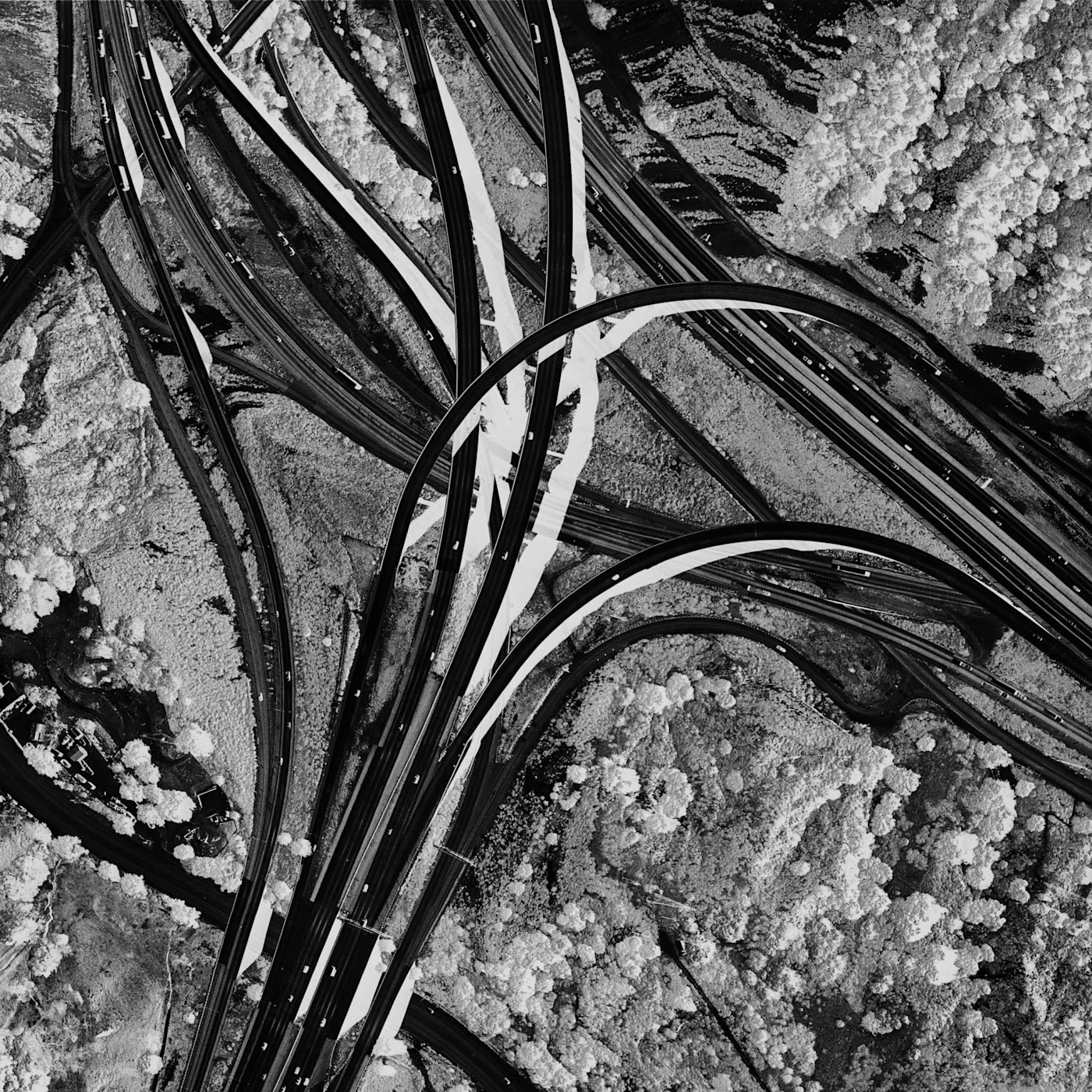
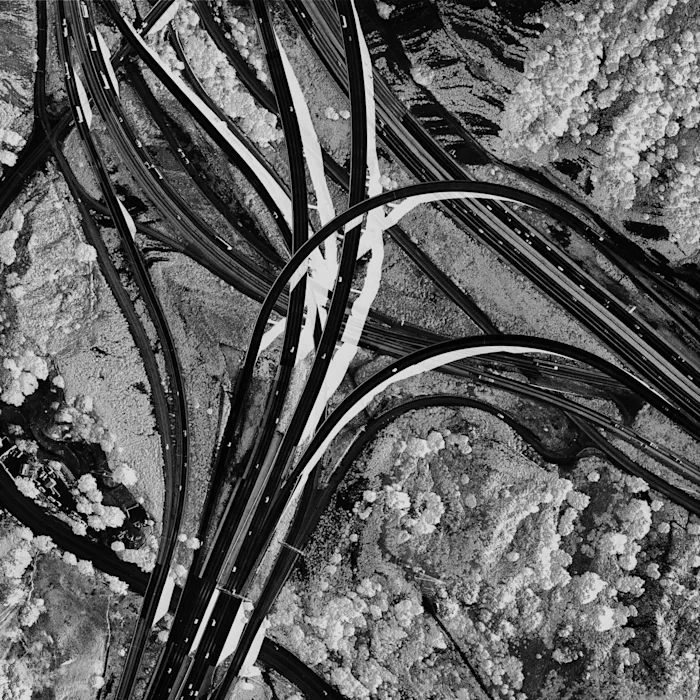
All life is knotted together into a trophic feedback loop in which pollinating animals and insects are needed in order for plants to reproduce. Plants, in turn, are needed in order for animals to eat and reproduce. Plants are also needed to regulate the carbon cycle and global weather and temperature. These, in turn, are required for most of the biosphere. Although we do not yet have accurate statistics for bacterial and fungal biomass decline, they currently make up a vast and crucial portion of global biomass, at 70 gigatons of carbon for bacteria and 12 gigatons for fungus.3 Bacteria and fungi support and flourish in biodiverse conditions and suffer adverse effects from deforestation and pesticides.
Wild plants, and especially mammals, have been killed off in huge numbers to be replaced by a few abundant crops and domesticated animals such as cows and pigs. But all the earth’s livestock still only comes to a tiny 0.1 gigaton of carbon, living at the expense of the much larger mass of plants, insects, reptiles, birds, wild land, and marine mammals that it has displaced.4
A brief history of ecocide
Ecocide is the destruction and reduction of energetic dissipation on the earth. It is also a kinocide because it produces a generalized slowing down of planetary dissipation. Each trophic level (mineral, atmospheric, vegetal, animal) is part of an energetic pyramid, with higher total energies below (mineral) and faster rates of expenditure on top (animal).
The higher you go on the pyramid, the more the organization of matter is in flux. This is why the earth has had five mass plant and animal extinctions already. When a lower-level event — such as solar flares, meteor assaults from the Milky Way, super volcanoes, changes in atmospheric carbon, or changes in phytomass occurs, everything above that on the pyramid is also radically and systematically affected, through a series of feedback loops. Certain groups of humans have now directly and indirectly affected the kinetic patterns of the earth at every trophic level.
At the end of the last ice age and the beginning of the Holocene, the earth exploded with new flora and fauna. Just from 16,000 BCE to 3,000 BCE, tropical forests tripled and cool-temperature forests expanded thirtyfold.5 Total phytomass during this time was, in all likelihood, more than 1,000 gigatons of carbon —well over twice today’s levels. From the rise of ancient civilizations and states (c. 3500 BCE ) to the beginning of the nineteenth century, 20% of global phytomass had been destroyed (taking it down to 750 gigatons). And then, in just the last two centuries alone, more than 30% of all remaining phytomass was destroyed due to the rise of industry, capitalism, colonization, deforestation, desertification, and species extinction (taking it down to 500–550 gigatons) (see Figure 15.1).6
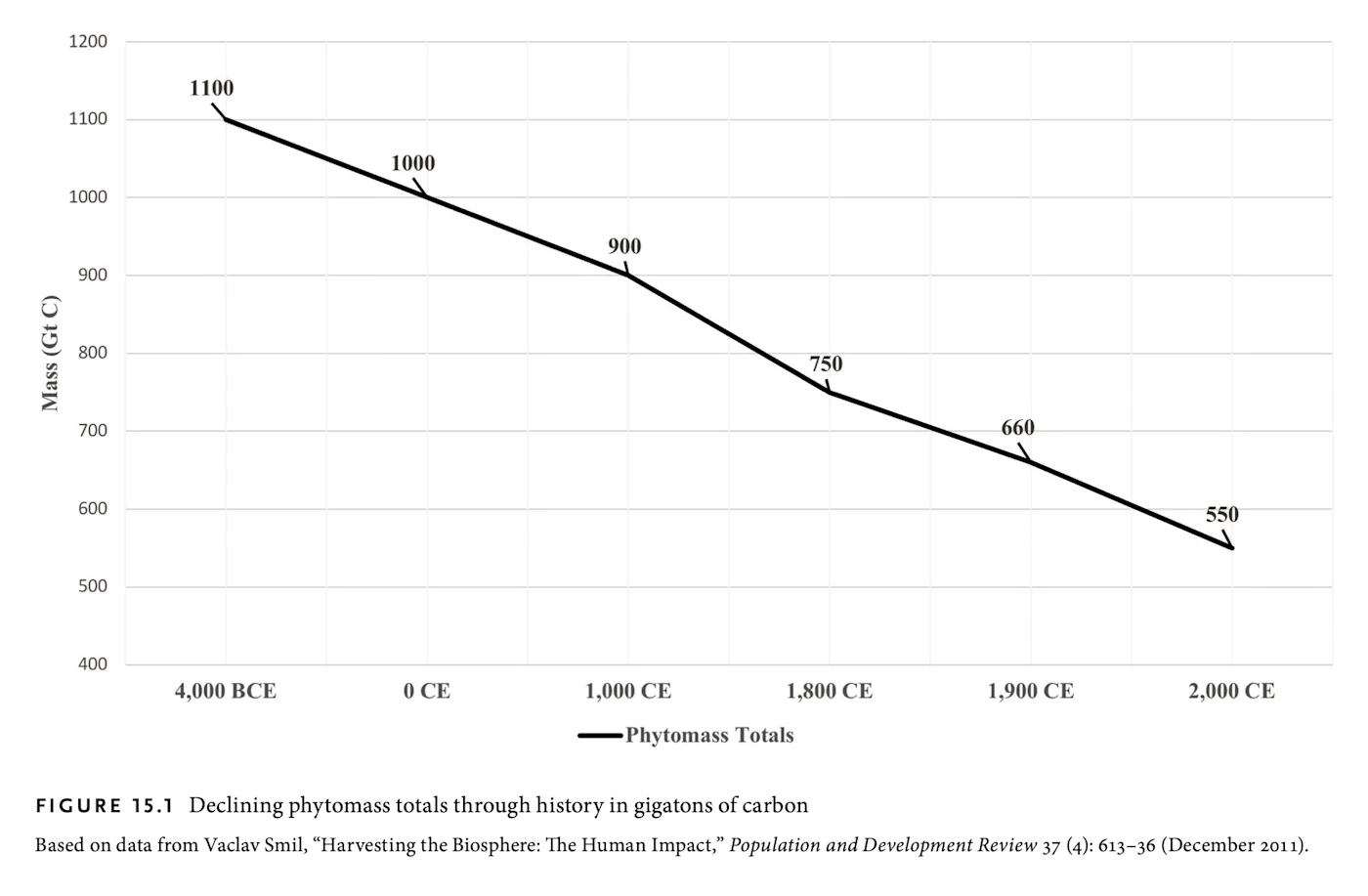

Since phytomass (the biomass of plants) accounts for 80% of total biomass, it also accounts for 80% of the total energetic value of planetary biomass. One gigaton of carbon, for example, is 1 × 1021 joules of energy. We can, therefore, see a clear and dramatic net decline in planetary expenditure directly related to the decline just in stored phytomass alone — which, as we have seen, is only around 1% of plant energy expenditure. See, again, figure 15.1.
The history of ecocide is long and has already been the subject of numerous books.7 This body of work, including two of my own books on migration and borders,8 shows clearly, in my view, that the history of biomass destruction and increasing energy consumption in human history is unquestionably dependent on social inequality and forced migration. This is especially true with the advent of the capitalist-driven fossil fuel extraction, deforestation, colonization, slavery, and energy wars that began in earnest in the 19th and 20th centuries.
Every major social formation in Near Eastern and Western history expanded its scope and speed of circulation through the kinetic expulsion of human and nonhuman migrant populations. As far back as the Neolithic, some humans were expanding agriculture by expelling nomads, wild plants, and animals into forced migration — ultimately deforesting and depleting the Fertile Crescent. In the ancient world, the Sumerian, Egyptian, Greek, and Roman empires built themselves on the backs of “barbarian” slaves who were forced into migration from other areas in order to mine fuels, fight resource wars, and build the infrastructure of empire.
The early modern legal and penal system emerged on the backs of feudal serfs and the criminalization of vagabonds. Finally, the capitalist economic system expanded private property through the forced expulsion of peasants around the world (the English, the Irish, enslaved Africans, American Indians, and others) from their land and into waged or unpaid labor. Wild “wasted” lands were clear-cut, and biodiversity devastated in favor of grassy “sheep walks.” Social expansion was always a social and ecological expulsion of migrants, both human and nonhuman.9
Today the fossil-fuel-using classes and their scientists talk about our epoch as one of “human” geological agency — as if all humans played an equal role in the disaster. In fact, in every major age of Western history, it has been a proportionally small group of powerful consumers that forced the rest of the planet to destroy the biosphere and one another through enslavement, migration, and genocide.
The data on this is clear: the history of phytomass destruction is directly correlated to the history of energy consumption by the fossil-fuel-using classes, the rise of capitalism, and colonialism. We can see in Figure 15.2 that the sharp rise in human energy expenditure is inversely related to the sharp decline in biomass in Figure 15.1.
Together, Figures 15.1 and 15.2 reveal a clear image of the decline in the capacity for planetary kinetic expenditure connected to the rise in human energy use, which required ecological destruction.
A geology of the present
One incredible consequence of the massive terraforming project of capitalist globalization is that it has resulted in one of the most mobile geological strata of all time. Humans have always been geological agents, but to varying degrees. All the patterns of motion from throughout the earth’s history (centripetal, centrifugal, tensional, and elastic) are thus still present today, but in a new mixture.
A new minerality
Many human groups have thrown a wide range of different minerals into circulation in the form of vehicles (cars, trains, planes, boats), living bodies (humans, animals, plants), and space debris (rocket parts, satellites) across the surface, the sky, and space. Capitalists have dug minerals out of the earth, turned them into technologies, and moved them all over the world in a massive metastable geological stratum. Bones, especially those of farm animals, now compose an entire fossil mineral record. There is also a sedimentary layer of plastic and petroleum products buried below our feet and coursing through our bodies. There are more than 500,000 pieces of debris, traveling at speeds of up to 17,500 mph, orbiting the earth. This is a new, highly mobile mineral stratum.
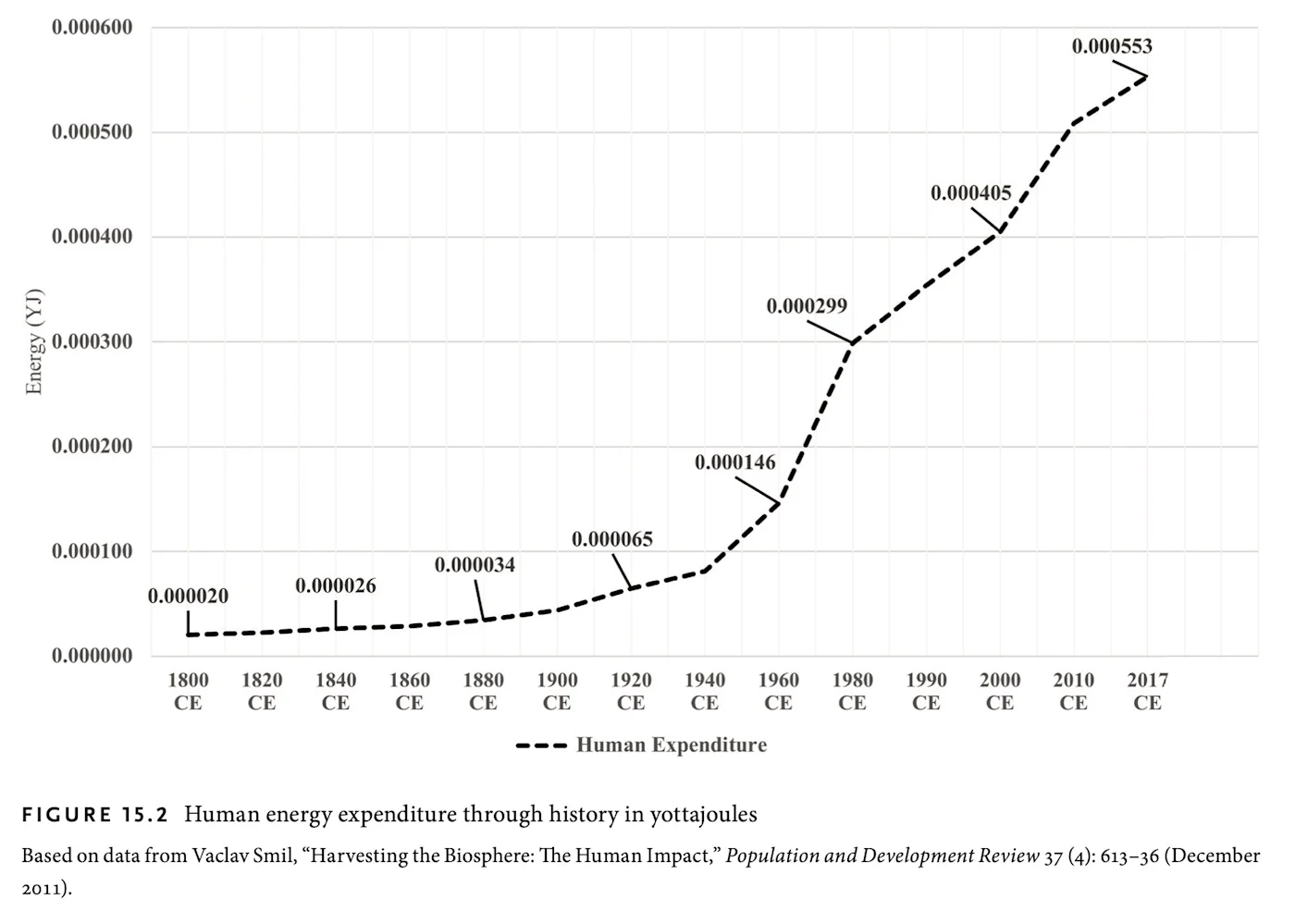

Additionally, as ice sheets melt from global warming, they take the weight off the land and trigger earthquakes. Seismic activity is increasing in Greenland and Alaska as a result. As seawater rises, the new weight bends the earth’s crust and can increase volcanic activity, submarine landslides, and tsunamis.10 Climate change is affecting the geological strata of the mineral earth.
A new atmosphere
The new atmosphere has layers of radio waves, airplanes (along with flying human bodies), various balloons, carbon dioxide concentrations, and ozone holes. Weather patterns are becoming more irregular, and some scientists now worry that climate change will lead to “cloud extinctions,” fundamentally altering the atmospheric strata. We could soon live in a world without stratocumulus clouds.11
For every degree Fahrenheit warmer that the planet gets, the number of lightning strikes increases by 7 percent.12 Increasing global temperatures also mean that the water cycle is moving faster, which means rising evaporation, heat waves, droughts, fires, and cyclones that try to dissipate that heat. As the atmosphere and oceans increasingly store our expended carbon, they also try to help dissipate that energy through massive storm systems and fires. But because they are trying to expend too much too quickly, they initiate feedback loops that decrease their long-term efficiency. Fires can be healthy for forests, but only when they are not too large or intense. Fires stimulate new growth in forests, which store more carbon. However, if the fires are too frequent or widespread, they will increase global temperatures faster than those temperatures can be reduced by new forests.
A new phytosphere
Climate change is not only destroying plant life; it is forcing it into migration. Plants are the first economic migrants. They, like the industrial proletariat, were seen by early English capitalists as unproductive, idle, squanderers of energy. The primitive accumulation or forced expulsion of peasants and indigenous people from their land went hand in hand with the forced expulsion of biodiverse plants and animals. The rise of mass industrial agriculture was both an ecological and a human genocide at the same time. The invention of the capitalist plantation was an enslavement of the ecosystem and of black and brown human beings at the same time.
The philosophical belief in the inferiority of “matter” is related to the treatment of the earth as passive, unproductive, and wasteful. This, in turn, is connected to the treatment of black people as coal and brown people as dirt.13 For the English, colonization was not just a project of accumulation — it was a plan for the natural development of the productive forces of the earth that indigenous people, without good plantations to make use of them, were “squandering.”
Plants, like numerous indigenous people, migrants, and refugees, are now in forced migration.14 Capitalists ship plants around the world as food and fuel. They even burn their dead bodies as fossil fuel. A new phytosphere of “power-plants” and “plant-ations” is replacing the kinetic structure of vegetal life with smokestacks that release carbon but do not absorb it again.
Increasing carbon dioxide is also resulting in less nutritious food.15 An entire stratum of vegetal life is now changing its nutrient composition, making it less and less able to support higher trophic levels.
A new animality
Contemporary animality has suffered a similar fate. Various human groups have destroyed more than 80% of wild land and sea mammal biomass, leaving only the most “productive” domesticated animals, locked into the factory farm: the Plantationocene. Wild animals, like plants, are being forced to migrate north to avoid rising temperatures and tides — or die. The bodily morphologies and organs of animals that are meant to increase kinetic expenditure are now being bred and sculpted into “productive” meat machines. As the elasticity of the human animal expands across the globe, the elasticity of wild animals is contracting into extinction.
Beyond anthropocentric energetics
Here is the problem: all the “increased” planetary mobility of this new geology is only an increase relative to human history and scale. Relative to human history and human energy use, there is certainly a dramatic increase in planetary and even energetic mobility. But humans are not the only mobile users of energy. They make up only .01% of the biosphere, .0000000000082% of the earth, and an unfathomably small percentage of the cosmos.
From the broader and more inclusive perspective of cosmic and terrestrial expenditure, human energy use/ecocide is causing a net reduction in motion and energy expenditure on the earth as a whole. The current global consumption of energy by some humans more than others, including the relatively minor increases in mineral, atmospheric, vegetal, and animal motion caused by climate change, is incredibly tiny compared to total planetary expenditure, which dwarfs human energy use by several orders of magnitude. In the figure below, human expenditure is not even visible on the graph of planetary expenditure (see Figure 15.3). This does not mean, however, that the consequences of ecocide have been negligible.
Ecological energetics, ecological systems theory,16 energy accounting,17 embodied energy theory,18 and thermodynamics have done extremely important work to help put together the big picture of planetary energy use. Unfortunately, when it comes to thinking about human energy expenditure, energy scientists have entirely misinterpreted the ethical and philosophical consequences of their data. For example, physicists have interpreted the history of increasing energy consumption by certain groups of humans to mean that human animals are smart and energetically more “efficient” than nature. They treat human beings as evolutionarily, socially, cognitively, and technologically more advanced than other animals because of the sheer quantity of energy they expend.19 This is a terrible mistake.
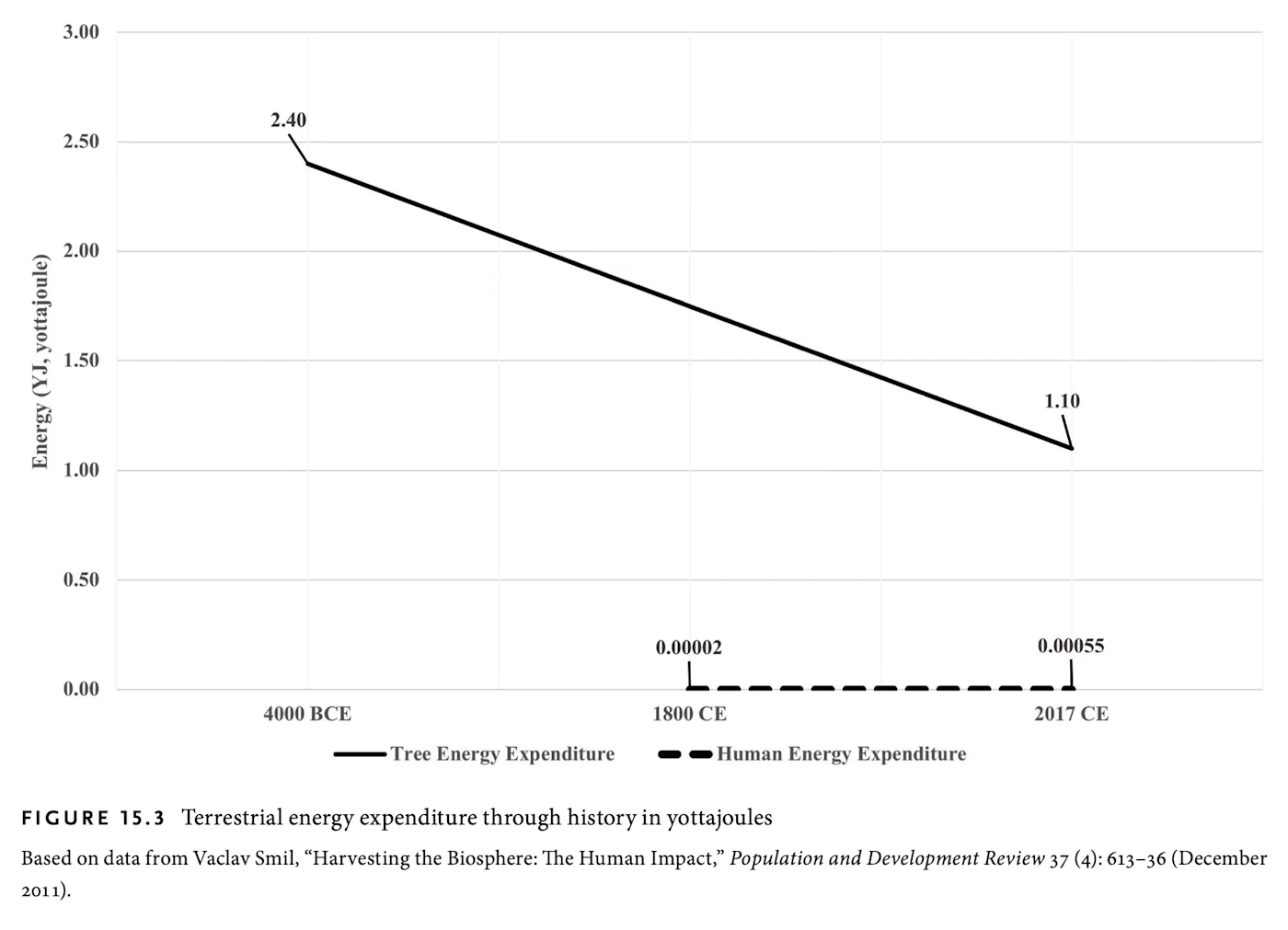

Fossil fuel capitalism is understood by some to be the highest form of human social organization because it allows for the largest possible consumption of energy.20 Many physicists and economists even describe capitalist economics as following directly from the laws of thermodynamics.21 Political liberalism is understood to be the highest form of political government because it maximizes the free energetic movement of all people toward increasing collective efficiency, productivity, consumption, and social-technological progress.22 What energy theorists fail to mention is that, at the same time, liberal governments have committed some of the most egregious human and ecological atrocities — and in just the past thirty years!23 Air pollution alone, coming disproportionately from liberal capitalist countries, is the cause of seven million deaths every year now and rising, largely killing people in developing countries.24 Is this the “success” to be reaped from liberal capitalist energy expenditure?
Even Georges Bataille, the great philosopher of expenditure, was deeply anthropocentric in his analysis of human expenditure. This led him in the wrong direction, toward the valorization of warfare, human sacrifice, and, implicitly, capitalist destruction.25 Humans are unique, for Bataille, because they expend the most energy and do so consciously. Religion is Bataille’s name for the uniquely human awareness of our cosmic destiny to maximize entropy. But Bataille was triply wrong: 1) humans, as we showed in the previous chapter, do not (by far) expend the most energy (trees do); 2) other living and non-living material processes have made active mistakes that have caused mass extinctions, and humans are thus not unique in their destruction or salvation of the cosmos; and 3) the historical tendency of the cosmos so far is not to merely increase entropy, which will happen no matter what we do, but to increase the rate of kinetic expenditure — which is a unique challenge faced by all of nature.
Due to these three errors, Bataille and others have ignored the declining rate of the earth’s total expenditure due to ecocide. This has allowed them to come to shortsighted, dangerous, and anthropocentric conclusions.
The historical tendency of nature to dissipate motion and energy is valid not for each aspect of nature in isolation, but only together, as entwined regions of an indeterminately changing and open whole. Humans are the cosmos continued by other experimental means to increase the expenditure of the planet and the cosmos, but not alone. There is thus absolutely no reason, other than pure anthropocentrism, for chaos and complexity theorists to treat humans as “successful” expenders of energy independent of their net effect on the planet and cosmos.
Energy theorists have understood the situation completely upside down. Biologists, on the other hand, understand well that each time an organism consumes energy, it expends an average 90% of that energy as waste. Each trophic level lives on the one below and expends nine-tenths of what it consumes each time, retaining only around 10% for what consumes it next. What organisms store as biomass is only a tiny fraction of a fraction of what life expends. Life tends to expend energy because the material cosmos does so more broadly. Nature loves to waste and to share its waste as much as possible. This is something our bodies “know” how to do. However, we tend not to consider it a real form of knowledge.
Unfortunately, most physicists and energy scholars are mostly interested in counting the tiny bit of energy or motion that is conserved and stored. Thus, ancient trees, at only 1% efficiency, are seen as grossly inefficient. Humans, at 16–20%, are understood to be better, and fossil fuels, at 30%, are considered ultra-efficient. Western culture and science have valorized efficiency, accumulation, and productivity under the assumption that nature and matter must be inefficient and stupid — thus requiring development and plantations to reach their true energetic potential. Kinetic expenditure is seen as an expression of the inferiority of the cosmos and evidence of the extraordinary superiority of human energy accumulation. We alone, with reason as our guide, can become efficient users of what nature so rapidly wastes. This is completely backward.
Notions of energy efficiency and environmental conservation are symptomatic of this same flawed framework, and we should alter them accordingly. Humans alone, in this model, are thought to be the unique consumers and conservers of nature. This is the prevailing definition of the Anthropocene, even though history and ecological energetics clearly show that numerous earth processes were destructive and restorative millions of years before humans.


When organisms and systems of all kinds suddenly begin to draw on a new dense energy source, there tends to be a period of extreme experimentation. What are the relative limits of how quickly and intensely organisms can consume energy without damaging the kinetic patterns that support them? Nature does not proceed along an a priori path to the fastest expenditure of energy, nor along a purely random one either. Nature experiments. Its first attempts are often destructive, as in the great die-off at the end of the Archean Eon caused by cyanobacteria expending too much energy in the form of oxygen. Certain human beings have also learned how to unlock relatively large amounts of energy from fossils, causing vast ecocide.
Planet-wide ecocide is the result not of too much planetary expenditure but of precisely the opposite: not enough! By maximizing total energy use for humans, the fossil-fuel-using classes on the earth have damaged the planet’s capacity for longer-term optimal kinetic expenditure.26 Their anthropocentrism has blinded them to the bigger picture of planetary expenditure. The effect is that they have ended up reducing the total net entropy of the planet, by destroying half the biomass on the earth, and, at the same time, have reduced the optimal rate of kinetic expenditure. As the earth’s temperature heats up, it disrupts the kinetic patterns, such as water and carbon cycles, that are much more rapid systems of expenditure than anything humans could ever dream of.27
What is to be done? In the next section, I would like to argue for a dramatic change in perspective and ethical practice, away from this humancentered energetics. A different Kinocene is possible: a Kinocene not of extinction, but of expenditure.
Kinocene Expenditure
Expenditure is a defining feature of the cosmos as we know it. Kinetic expenditure is the tendency of matter in motion to spread out from higher concentrations to lower ones. It is a movement of death that occasionally makes life so that life may know death as well. The Kinocene extinction, as I described it above, is not the same as death. Extinction is the death of death. It is the loss of life’s ability to die. In this final section, I would like to argue that what is needed more than ever today is an ethics of expenditure.
The ethics of death
The ethical valorization of life above death has wholly misunderstood the much larger cosmic situation in which our life occurs. Life is a kinetic byproduct of non-living matter’s movement toward increasing expenditure. The material meaning of life is to help improve the expenditure of the universe. The tendency of life is thus to die well together with others. An ethics of life, however, will not help us respond ethically to most of the earth and the universe — which are not alive. Furthermore, since we lack complete knowledge and control of even just our unconstructible planet, it is foolhardy to assume that we know or could know how to manage it, let alone the universe, properly, for the sake of life. And in fact, in the case of most of Western civilization, it has already been demonstrated that we do not know how to do that.
Death is different. Our bodies materially know how to expend energy and to die by wasting most of the energy they consume. Instead of trying to manage the world, they give themselves slowly and generously over to death. That is, they give themselves over to the rest of the world to consume and expend as best it can, without a pre-given plan for how to increase its rate of expenditure. In other words, the path toward increasing expenditure cannot be constructed in advance of our dying and living together as we go.
The ethics of kinetic expenditure is a complete inversion of the ethics of life. However, it is not a simple inversion. The inversion changes the relationship from one of increasing accumulation and instrumentalization to one of loss and generosity. Death is not an unfortunate part of life; instead, life is a part of death that reproduces itself — not in order to live but in order to die and help others die.
I do not mean to suggest with this ethical theory that the cosmos should die and that humans and other beings should help it. That would be a naturalistic fallacy. There is no such thing as an absolute should, anywhere in nature. The kinetic ethics of expenditure has a strictly hypothetical structure: if you want to survive and thrive in this particular universe as it has tended so far, then the best chance is to go with the flow of increasing your collective rate of expenditure.
Even this does not guarantee anything. Nothing controls nature, not even nature, which is continually experimenting, just like a bolt of lightning. A meteor can strike, or numerous organisms can cause mass extinctions. And perhaps some fossil fuel CEOs would rather live their individual lives in luxury at the expense of the long-term survival of the human species. But if the rest of us want to survive so our kind can expend itself with others into the future, then we have to quit our addiction to fossil fuels and abolish capitalism.
If we want to live and persist on the earth as one of its animals, then we have to give our lives generously back to the earth and help it hasten its dissipation. By undermining the efficiency of terrestrial expenditure (by biomass destruction, etc.), the fossil-fuel-using classes are not allowing the earth to die, nor to live so that it can die. The fossil-fuel-using classes are destroying the conditions of everyone’s expenditure. They are accumulating energy to use in the name of life. The paradox is that the instrumentalization and preservation of life are now resulting in extinction.
The problem is not that too much of the biosphere is dying, but that not enough of it is dying in the form of energy dissipation. Life is capable of vastly more expenditure if it is allowed to live out its death and help the rest of the earth to do the same.
Again, this ethical inversion of life and death is not whimsy or polemic. Placing death first changes our orientation, toward both life and death, entirely. Life and death take on wholly new meanings. Life is no longer about accumulation and preservation, but expenditure, and death is no longer an end state, but the process of expenditure itself.
We can either become what we are (expending animals), or we can act as if our purpose is to conserve, accumulate, and instrumentalize life. The latter tends to produce extinction, the former to extend life. The paradox is striking and deeply counterintuitive from within the Western tradition. To live, we must give ourselves over to death, expenditure, and loss, trusting others to give back. The valorization of life (biopolitics) produces its opposite: extinction and death. Pascal could not have been more wrong in saying that “our nature consists in movement. Absolute stillness is death.”28 He should have said that “our movement lies in nature; we are its death.”
If 6 trillion trees were still alive on this planet today, the earth would be expending twice as much energy as it is currently. The fossil-fuel-using classes are selfishly holding back the earth from its collective dissipation—its generous waste back to the cosmos. Whether we like it or not, we are directly participating in a larger cosmic drama. The cost of ignoring it and trying to hoard our own life will quite likely be our extinction. Perhaps the next round of post-extinction species will go with the flow instead of swimming against it, as certain human groups have — insisting that fighting against the current of nature is “knowledge” and “progress.”
The gift that the Western fossil classes can give back is to surrender their arrogant belief that they know more about nature than it does. They can sacrifice homo economicus. They can generously give back their death, without purpose, without expectation of an instrumental return on their investment.
The question is not whether total human energy use is increasing or decreasing, but rather whether the rate of terrestrial and cosmic expenditure is doing so. Mere quantitative increases in human energy, above a certain level, are the cause of the current decline in the rate of expenditure. The destruction begins first for nonhuman life, then spreads to populations affected by extraction, and, eventually, affects the biosphere as a whole.29
Higher energy consumption by the fossil-fuel-using classes does not increase the global rate of expenditure but lowers it, because the energy used is not reused, composted, or further degraded.30 Instead, the expended carbon is stored in the atmosphere and oceans, from where it is released by storms and fires that further destroy the earth’s ability to efficiently increase the rate of expenditure.
Against conservation
This is why the idea of conservation in all its forms (ecological, economic, epistemological, etc.) is “upside-down reasoning,” as Lucretius says.31 The key is to increase the rates and patterns of kinetic expenditure in such a way that the patterns sustain themselves, so that they can keep on experimenting and expending, like an ancient forest. In other words, nuclear annihilation, fossil fuel capitalism, and any process that destroys efficient kinetic patterns are ultimately self-destructive. They are bursts of expenditure that cause a net reduction in planetary kinetic experimentation, diversity, and dissipation.
This is a counterintuitive and challenging notion: the survival of the biosphere and of human animals is not the primary meaning of their material, kinetic, and historical existence. The continued survival of life, this tiny portion of nature, is an aftereffect of cosmic and planetary expenditure. Life survives, strives, and reproduces, not directly for itself or its own utility, growth, expansion, and progressive evolution, but for the sake of something else entirely: the expenditure and death of the cosmos. The emergence and evolution of life with all its kinetic morphologies is not directly for the sake of development. Life is a gift given to the organism to intensify the expenditure of the cosmos and itself. By dying well, it gets to live well.
Conservation and accumulation are not the aim of life but are, rather, the consequences of death and expenditure. We preserve only to expend the more. This inversion is not a “new instrumentalism” that merely uses life “for” expenditure. Expenditure itself has no purpose or utility precisely because it is not a reinvestment with a necessary guarantee or with any equality of exchange. Death may give back the aftereffect of life, or it may not, depending on the greater relational experiment. One organism’s gift of death does not decide what will receive the gift of life in return. This is a significant reversal that flips Western thinking on its head.


The gift of death thus has a dual meaning: life gives itself over to the cosmos in death, but death (non-living matter) gives itself, as a gift of life in cosmic reciprocity. Reciprocity is never an equal exchange, because the cosmos tends to move toward increasing rates and diverse forms of expenditure: toward death. There is no symmetrical balance. At the end of the universe, there is not necessarily homogeneous heat death, because matter is fundamentally in pedetic motion.
The cosmos, by giving itself the gift of death, also gives itself the gift of life by possibly contracting back on itself, reversing entropy, and producing a big crunch and another big bang. But since each life and death of the cosmos is related to its prior expansions and contractions through the initial and final states of quantum indeterminacy, the relation remains asymmetrical and indeterminate. The cosmos is relational but not determined, proportional, or symmetrical. The life and death of a cosmos thus mirror the life and death of all cosmoi in ongoing cycles of creation and destruction.
The logic of conservation, as a primary goal of ecological ethics, urges us to live a life of austerity, simplicity, and personal virtue. It rejects our urge to destroy, to waste, and to expend without utility or purpose. If humans want to survive, conservationists say, we must ration our resources, tighten our belts, renounce our desires for senseless expenditure, and further develop our higher rational and moral selves.32 Deep ecologists and Earth First!ers even renounce human beings themselves, as a virus upon the earth. They say that we must depopulate so that the intrinsically valuable and naturally conservative biosphere may thrive for its own sake.
Thinking about ethics in terms of expenditure, however, is not a merely formal change in interpretation that leads us to the same practical activity of conservation. The logical conclusions of conservation ethics — such as population management, the preservation of wildlife at the expense of Third-World lives, the “voluntary human extinction project” of human sterilization, and the reduction of human activity to mere survival — do not follow from the ethics of expenditure. The Kinocene ethics of expenditure is quite different from the conservationist logic. The logic of conservation is a logic of renunciation, asceticism, and negation.
Moderate and radical environmentalists alike, even when they rail against anthropocentrism, remain fundamentally human-centered and rationalistic in a sense. They project onto all life the ideal of conservation, self-preservation, and biological survival because humans are alive and seem to culturally value conservation. However, conservation and preservation are simply not what nature does, 90% of the time.33 What we call “conservation” is an indirect byproduct of expenditure.
Life is one of the most profligate expenders and consumers of energy per mass that we know of — at a rate per area that is many times greater than that of the sun itself! Trees, for example, show us precisely what they think of the idea of conservation, consuming yottajoules of energy just to excrete 99% of it out again. Trees “conserve” 1% — just enough to preserve themselves so that they can keep wasting. Naturalism is not consistent with conservation.
Capitalism and anthropocentrism are destroying the planet, and we ought to stop them if we want to survive. However, the logic of conservation follows the same instrumental logic as capitalist bio- and anthropocentrism, only directed toward other ends. The results of deep ecological, NeoMalthusian anti-humanism have been and will be devastating for women and people of color around the world.
Instead of doing what we think trees do (conservation), we should (if we want to survive) be doing what they and our own bodies are truly doing. Trees are all wasting themselves into the world in acts of generosity, only taking what is given back to them, in reciprocity, to squander it again. It is hard to let go of the drive to manage and construct nature toward what we imagine is a better goal, or what we believe is consistent with the benevolence of Gaia. However, that is what the ethics of kinetic expenditure asks of us.
In Greek mythology, Python, the dying serpent, was the voice of Gaia. The critical idea here is that the truth of the earth is spoken and known through the act of dissipation (the rotting serpent Python). Like the priestesses of Delphi, we have to listen to the earth and follow its lead if we want to survive.
Reciprocity
Reciprocity in this context means giving as much as we can in expenditure and taking back what nature gives in return. Conservation is the tiny aftereffect of this more primary kinetic process, which saves just enough to keep on expending. This means that reciprocity is fundamentally collective, or held in common. It means that a kinetic ethics for the Kinocene is about dying or expending well together. It means that everything on the earth should waste or throw into circulation as much as it can, but not so much that it undermines the larger capacity of the earth and others to do the same. Everything on the earth, living and non-living, helps the rest of us to dissipate well together. That is the generosity of death, which gives the gift of life.
The problem is not that fossil capitalism wastes too much, but that it does not waste enough, and that it does not take enough from the earth. Pumping carbon into the atmosphere and destroying the earth’s biomass destroys the conditions of increased intensity of expenditure, and it does not take the gifts of carbon offered back in return. Fossil fuel consumers are expending carbon into the atmosphere, and into the oceans, in enormous quantities: 2 × 1023 joules total over the past twenty-five years into the sea alone. This is the energetic equivalent of three atomic bomb explosions every second for twenty-five years.34 This prevents the earth both from expending and from receiving. It disrupts the reciprocity of the carbon cycle, whose ultimate aim is to release energy back to the cosmos.
Reciprocity means giving to others so that they can again give to yet others — not destroying the conditions of giving. Reciprocity means taking what nature gives, not refusing it, or destroying the conditions of the giving. It is a cruel irony that the very stuff of life, carbon, has now become the great herald of extinction: the death of death.
Against capitalism
Capitalist economics is premised, in direct contrast to this kinetic reciprocity, on the fundamentally false notion of equality of exchange: equivalence. Note that in nature, there is no such thing. Nature is neither identical to itself at any point nor identical between points of itself, if for no other reason than because of spatiotemporal difference. Matter always flows asymmetrically, entropically, and in metastable patterns of increasing disequilibrium. Equivalence and equilibrium are, physically speaking, violations of the historical tendency of the universe, which is to dissipate and spread out kinetically.
By acting as if equivalence, equilibrium, identity, and exchange were real aspects of nature, economics and capitalist economics, in particular, have significantly damaged the earth’s capacity to increase its rate of expenditure. When one acts as if nature moves in one way, when in fact it moves in another, massive disruptions in those motions occur. Capitalist constructivists have acted as if they could invent or construct a set of rules on top of nature and live in their own reality. They are like someone swimming upstream who insists that that’s the easiest, most natural way.
Classical, neoclassical, and orthodox economic theory also act as if economic exchange were a reversible process, when, physically speaking, it is not. The philosophical assumption of economics since David Hume has been that scarcity is the basis and starting point of economics, when in fact, as we have shown, nothing of the sort exists in nature. The ideas of equivalence, equilibrium, reversibility, and scarcity are false — meaning they have not been physically found in nature so far.35
Classical and neoclassical economics also believe that production and consumption are circular. They think that what humans produce is what they consume, exactly, without expenditure, externality, waste, or degradation. This is, again, thermodynamically impossible. Movement always tends toward increasing dissipation. As Harold Morowitz says, “Energy flows; matter cycles.”36 As matter cycles, energy flows through it. What is consumed is never identical to what is produced.37 Therefore, there can be no equality of exchange, physically speaking.


By acting as if a commodity were strictly identical to its exchange value (how much money someone exchanges for it), capitalist economics has failed to consider the environmental impacts of deforestation, pollution, and climate change. It has also ignored the human implications of social devalorization (in such forms as racism, sexism, and classism) as integral and constitutive aspects of the economic process. These aspects have no value in capitalist economics.
As Marx rightly says, capitalists act as if the product were abstracted or independent from the process that produced it. The monetary value of an old-growth tree is reducible to 1% of its energy, which is usable for humans as biomass or “lumber.” The rest of the 99% of its expenditure is “wasted,” without any value. If we assigned even a modest monetary value to the tree’s energy expenditure, or to women’s domestic labor, or to migration and human displacement (for example), profit would be impossible. This does not mean that we should try to assign monetary values to natural processes! It means that the whole idea of capitalist economics and “value” is utterly absurd. Value necessarily requires the constitutive exclusion of the material-kinetic conditions that support its abstract exchange process.38
Because it privileges life, accumulation, conservation, and utility, capitalism excludes and destroys everything that it associates with death, expenditure, reciprocity, and non-useful waste. Hence the apparent and logical necessity of ecocide, indigenous genocide, slavery, patriarchy, forced migration, and biopolitics.39
Compost ethics
Composting works by a different ethos. It is the expenditure of expenditure. In this sense, it is the gift of death: the opposite of capitalist utility and accumulation. Composting shares used and wasted matter with mineral, atmospheric, vegetal, fungi, and animal others, to be used and expended again and again. Each compost cycle further degrades and dissipates energy as it increases the capacity of the earth for further degradation.
For example, the composting of garden and food scraps allows for the creation of new fungi and bacteria. Once they break the compost down, it is returned to the soil to increase the symbiotic relationships among fungi, bacteria, and plants in the ground. Humans then eat a portion of the compost that becomes food. They burn most of it into the air as heat when they move, and their solid waste can return to the earth to be broken down again by bacteria.
The problem is that when we bury our “trash” in landfills, it actually slows down or even arrests the composting process. The invention of nonbiodegradable petroleum products is the modern expression of our fear of death and our quest for immortality. We will not even let our waste die. Landfills deny the gift of death and, thus, the gift of life. They prevent expenditure by preventing the expenditure of expenditure.
Compost is not about conservation; it is about waste, shared among a wide community of consumers who thoroughly and efficiently, and faster, break down and expend the energy of the waste back to the cosmos, as heat loss into space. Recycling and reusing is not conservation; it is a way to extract and expend and share matter with the earth more generously, so that we can all die and dissipate well together.
Carbon sequestration is also composting. The oceans, atmosphere, plants, and animals all sequester and compost carbon. Biological sequestration may even be responsible for regulating the earth’s climate over billions of years, as the sun has continued to get larger and hotter.40 The problem is that the fossil-fuel-using classes are destroying our compost piles by overfilling them. Every backyard composter knows that active compost produces heat, but dropping an atomic bomb into your compost would produce so much heat that it would destroy the entire metastable process of kinetic degradation. This is what we are currently doing.
As the ocean stores more heat, it begins to swell by thermal expansion, causing sea-level rise, increasing erosion, and increased nitrogen and thus further increasing temperature in a terrible feedback loop. Eventually, as in every historical greenhouse age, the cycle will run its course and reach a new metastable state. But if we want to live through the process, we need to start composting much more, much faster. This effectively means that we need to facilitate an increased rate of expenditure for existing waste, not conserve it.
Diversity
Social and ecological diversity both increase the rate of kinetic expenditure. Old climax-stage forests are the largest dissipative systems on the planet because they are the most diverse. In old, diverse forest and jungle ecosystems, each organism lives from the waste products of others. The more ways of living there are, the more ways there are to consume and expend different energy sources: thus the very rapid intensity of expenditure. No single organism can use all energy sources, so nature requires an army of specialized levels, relations, and singular techniques in order to capture and fully degrade and dissipate 99% of all incoming solar energy.
However, high rates of energy expenditure, as in climax ecosystems, should not be confused with “high” total energy consumption, as with fossil fuels. Fossil fuel use, for example, does not necessarily require or create social or cultural diversity. Choosing between different kinds of commodities is not the same as social or ecological diversity. Where fossil fuel energy expenditure is the largest in quantity, we see some of the highest gender, race, and class disparities in wealth and education.41
Humans are natural, and thus human diversity is part of ecological diversity. Technologies created by humans are also natural and, therefore, also part of environmental diversity. Human plasticity is at the same time social, technological, and ecological. The more kinds of people and technologies there are, living in the more diverse ways, the more thoroughly we will be able to degrade and expend planetary energy. However, this is true only as long as some of these ways do not reduce the capacity of others (living and non-living) for diverse dissipation.
Human diversity is also like a dendritic lightning strike that tries out living in different ways, in different places, with different techniques, cultures, and technologies. The more forms of thinking, doing, and being there are, the more varied the methods of energetic expenditure. Just as there is no one organism or way to extract energy in an ecosystem, there is no one human social ecology either.
If humans want to survive, they need to increase the rate of long-term planetary expenditure. To do that, they will need a plurality of techniques that respond to the singularities of their geography. In other words, humans need to multiply their values, habits, technologies, and cultures with and as part of ecological diversity more broadly.
Global urbanization, extractive capitalism, and climate change are all forcing people to migrate from diverse geographies and ways of life into cities with common economic, legal, and political forms. A new ethics for Kinocene expenditure must also be one that supports the free movement of people and their right to stay home and resist extractive capitalism. Decreasing biodiversity and rising global temperatures due to extraction and plantation agriculture also increase political conflict, social instability, and forced migration.42
Colonialism has eradicated and continues to eradicate diverse indigenous peoples, who also tend to live in some of the most historically diverse and dissipative ecosystems on the earth. Ecocide is thus fully entangled with the genocide of indigenous peoples who rely on and identify themselves with their land. The killing off of the buffalo in North America, for example, affected the entire ecosystem and the indigenous people on every level.43
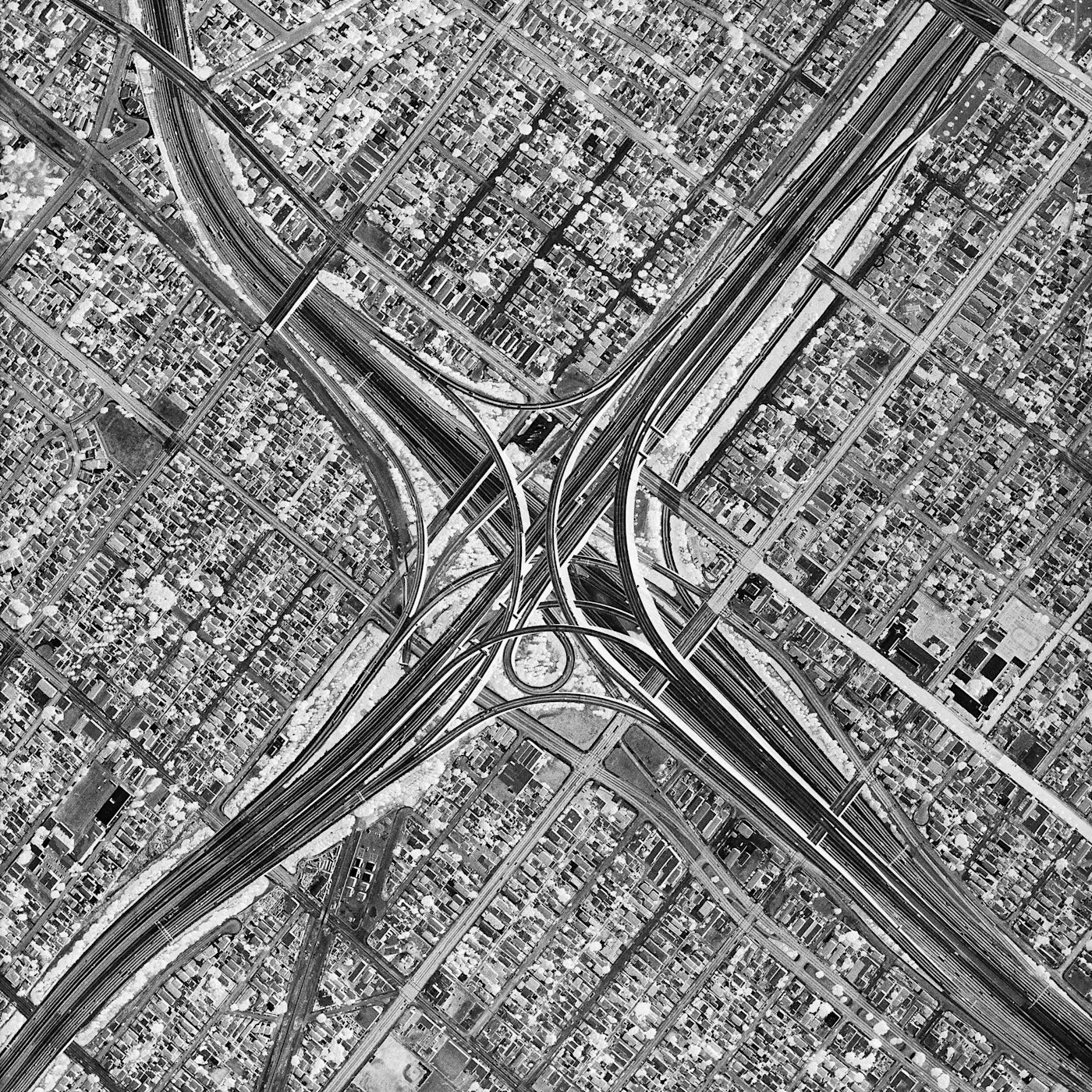

Fossil-fuel-based plantation agriculture also reduces the net expenditure of the earth. The homogenization of seeds by Monsanto and industrial farming not only limits the diversity of farming conditions but also creates mono-crop plantations that are vulnerable to disease and climate change.44
Rural and indigenous women are particularly vulnerable to ecological destruction because they depend on forests and common lands for food, fodder, water, and building materials.45 For many women, destroying their forests is equivalent to killing them and their families.46 When crops fail, it is women and girls who are disproportionally affected by famine.47
In addition, the institutions and habits of patriarchy, by restricting what everyone, but especially women, is allowed to do with their bodies and lives, homogenize a range of gendered and sexual diversity and ways of expending energy.
Art, culture, and sexuality are also techniques that expend energy. When we restrict freedom and experimentation in those realms, we end up with, again, fewer ways for humans to waste their metabolic energy. Nature is queer and loves to multiply sexes, genders, and sexualities to see if new ways of life might increase the rate of expenditure.48 If we want to survive, we need to find new and diverse paths to enjoy the expenditure of our energy — as long as these ways do not destroy the conditions for further experimentation and expenditure for others.
The subsistence farming, hunting, and gathering that takes place in many countries looks like poverty to capitalists because it has little or no monetary value on the world market. However, by using, expending, and composting on traditional lands, indigenous people support higher rates of ecological and planetary expenditure.
If we want to find new sources of compostable energy, we need to support as many different ways of living as we can that do not destroy the possibility of this “kinetic pluralism” itself. The reduction of ecological diversity also destroys human ways of living, speaking, and knowing. Fossil fuel migrants are forced out of their homes to make way for plantation agriculture and energy extraction and, at the same time, are forced into the fossil fuel economies of Western receiving countries. There is thus a double destruction of human and ecological diversity, and a double decrease in planetary expenditure, as sustainable human/natural ecologies and the people who live in them are forced to migrate and reproduce fossil fuel societies.
By allowing more of the world’s population to eat, and not starve, supporting as many diverse ways of living as possible would mean an increase in the planetary rate of expenditure, since human metabolism is incredibly efficient relative to its mass. Poverty, capitalism, and colonialism are thus antithetical to human diversity and human expenditure, since they keep people from dissipating a surplus of energy. The real primary problem is not human population levels, as some environmentalists claim, but fossil fuel capitalism and the patriarchal control over women’s reproduction.49
Social domination, from a kinetic and thermodynamic perspective, is a reduction of the human ability to experiment freely with new and different ways of expenditure. There is nothing in nature (no great chain of being) that justifies the social domination of others. In nature there is only the tendency to allow increasing experiments in motion and expenditure that do not undermine further experiments toward increasing expenditure.
Metabolic communism
The ethics of expenditure in the Kinocene also entails a new relationship with the “commons.” Historically, humans have understood the commons to be the common pool of resources to be managed collectively. Under capitalism, these resources were directly appropriated through primitive accumulation (by theft, murder, colonialism, extraction, and privatization). Although quite different, both of these approaches to the commons have understood the commons to be a “pool of resources” for human use (whether managed, conserved, or devastated).
The kinetic theory of the earth requires a much deeper and broader approach to the commons. If we want to survive, we need a materialist commons, where we treat each main pattern of the earth’s motion as a commons for the others. Together, all the earth’s material processes are sympoietic with one another and thus “manage” one another and themselves as commons for others. We need a reciprocal commons, in which each body becomes the commons of others, to be directed together toward increasing expenditure. Thus, instead of “the commons,” we should be thinking about the kinetic process of “commoning” as the making and remaking of a material (and not just multispecies) commons that we are continually expending, composting, and transforming.50
This new commons, or what I am calling “kinetic communism,” would be based not on conservation but on expenditure. What if we all managed and shared one another’s food and waste not for the sake of hoarding, rationing, or saving it but for the sake of wasting it into space? Conservation is only a tiny and temporary stage required to sustain the most optimal expenditures our planet can support.
This is not only a terrestrial task but a cosmic one. The metabolic commons is also a cosmic commons in which the sun, solar system, and broader universe participate directly in self-degradation. The cosmos is a commons for itself in order to unravel itself. The earth is a commons used by the sun to degrade its energy, while the sun is a commons for the earth to expend back into space.
There is no single “best” way to manage our commons. The more ways we try together and the more we allow new material evolutions to experiment, the more likely we are to optimally expend energy. The more tributaries of a river, the more rapid its diffusion. Furthermore, since the earth is always changing, so too should our strategies for diffusion. Kinetic or metabolic communism is the process of preserving the commons just enough to optimize its expenditure and increase its processes of differentiation. Nature continually struggles to become other than it is, in order to expend itself faster.
Kinetic communism would entail the practical collective metabolic management of the whole planetary form of motion. Kinetic communism is nothing other than the practical and commonsense joint management of the threefold (natural, human, and social) metabolic and material process in such a way as to avoid destroying its own conditions for collective planetary expenditure.
If this kinetic ethics had to be put into three memorable and straightforward ethical imperatives, in the fashion of Epicurus, here is what they would be:
If we want to survive, then our best chance is to follow these guiding maxims:
Increase planetary expenditure.
Compost everything!
Increase diversity.
Across the material spectrum, these are the conditions under which increased planetary expenditure takes place.
I am sure people will misunderstand this ethics of expenditure, so let me try to clarify two points:
I am not deriving a universal “ought” from a naturalistic “is.” The ethics of expenditure is strictly hypothetical and experimental: “if we want to survive, then our best chance is to try to increase collective planetary expenditure.”
I am also not saying that all human ethical practices can be explained by or reduced to the ethics of expenditure. Human ethical practices are not unimportant or irrelevant in the face of cosmic and planetary processes; quite the opposite. Human ethics are part of nature and its processes — something we often forget. Increasing natural diversity also means increasing the diversity of human values, ethics, and ways of being. The ethics of expenditure is thus not meant to resolve every ethical dispute among humans. It aims to situate human ethical activity itself in nature, in order to curb our present problem of rampant human-centric behavior and constructivism.
The ethics of kinetic expenditure is not a universal ethical ground but a hypothetical ethical ground. It allows us to say not only that capitalism is descriptively wrong about nature, but also that it is unethical (assuming that we want to survive), because it leads to the reduction of planetary expenditure (including the reduction of human and ecological diversity and flourishing).
Furthermore, the ethics of expenditure relates to the material conditions of all human society as such. If we even want to have humanistic ethics in the first place, there must be humans alive to practice it. Thus, implicit in all humanist ethics is the assumption of planetary existence and survival. In short: If we want human ethics, then we need to be alive and survive, and if we’re going to survive, then we need to try to increase planetary expenditure (with all that entails). Kinocene ethics, then, is perhaps a “metaethics.”
I am not interested in valorizing death over life or nature over humans in a way that would reduce everything to merely meaningless natural processes — thus undermining social critique and human ethics. I am trying to bring naturalism and humanism back together in order to avoid the false dichotomy between human values and valueless nature. Human ethics does not occur in a constructivist vacuum but under specific natural and historical conditions that are directly relevant to our living, and living well. This is what I have tried to show.
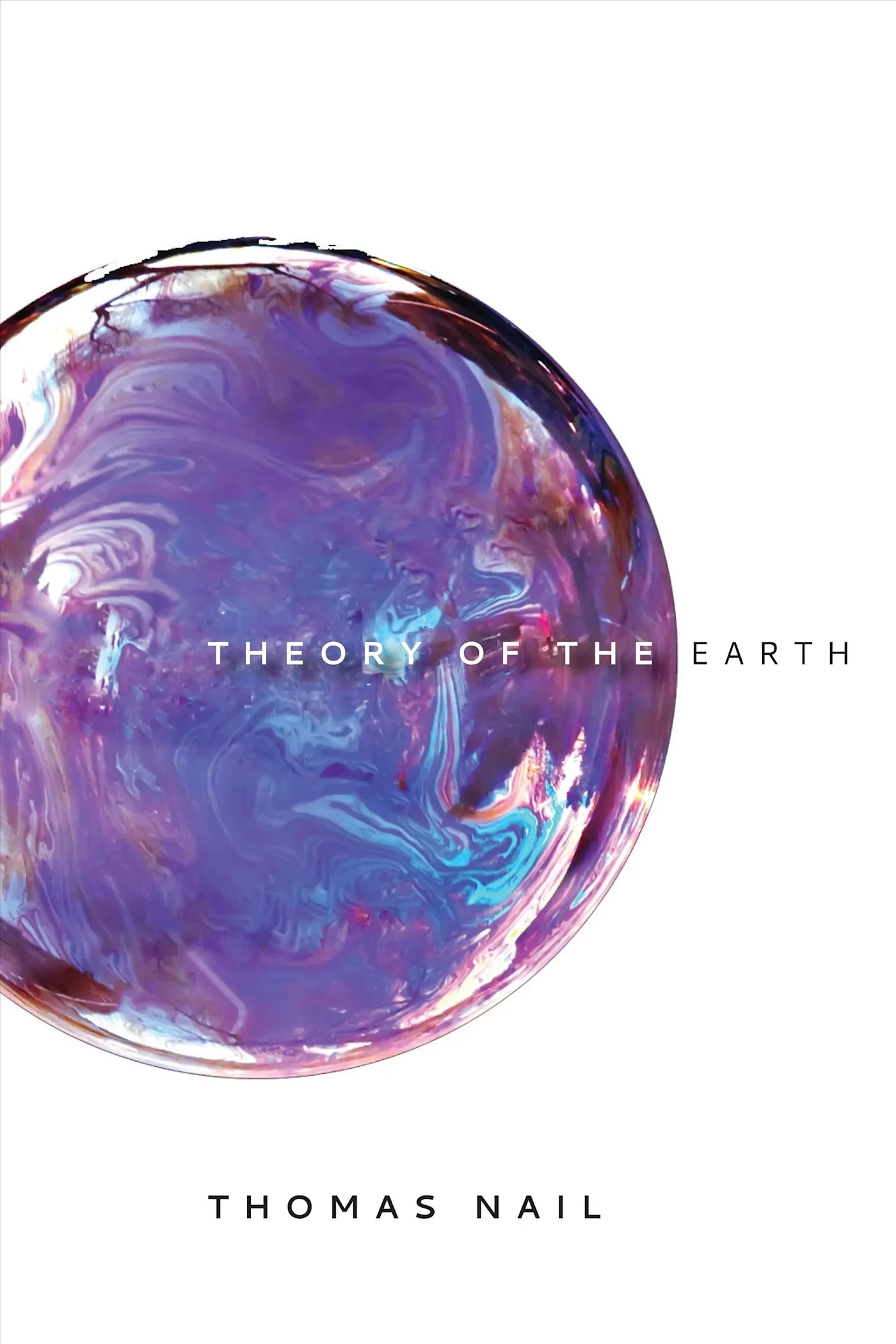
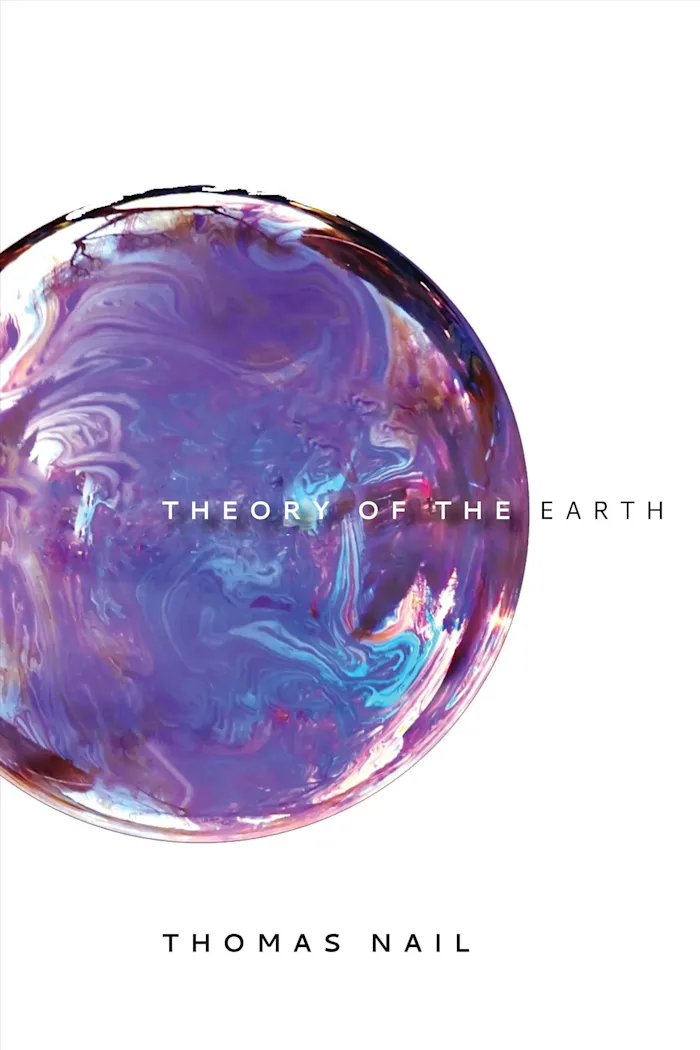
Theory of the Earth is available through Stanford University Press.
Images: David Maisel
Notes
1. Sagan, Cosmic Apprentice, 235.↰
2. See Yinon M. Bar-On, Rob Phillips, and Ron Milo, “The Biomass Distribution on Earth,” Proceedings of the National Academy of Sciences Jun 2018, 115 (25) 6506–11. For a nice summary and framing of human impact, see John Vidal, “The Rapid Decline of the Natural World Is A Crisis Even Bigger than Climate Change,” Huffington Post, 03/15/2019. Online here.↰
3. Bar-On, Phillips, and Milo, “The Biomass Distribution on Earth.”↰
4. See image in ibid.↰
5. J. M. Adams and H. Faure, “A New Estimate of Changing Carbon Storage on Land Since the Last Glacial Maximum, Based on Global Land Ecosystem Reconstruction,” Global and Planetary Change 16–17 (1998): 3–24.↰
6. See R.A. Houghton, “Why Are Estimates of the Terrestrial Carbon Balance So Different?,” Global Change Biology 9, no. 4 (Apr 2003): 500–509; and Sassan S. Saatchi, Nancy L. Harris, Sandra Brown, Michael Lefsky, Edward T. A. Mitchard, William Salas, Brian R. Zutta, Wolfgang Buermann, Simon L. Lewis, Stephen Hagen, Silvia Petrova, Lee White, Miles Silman, and Alexandra Morel, “Benchmark Map of Forest Carbon Stocks in Tropical Regions across Three Continents,” PNAS 108, no. 24 (Jun 2011): 9899–904.↰
7. Benjamin D. Lieberman and Elizabeth Gordon, Climate Change in Human History: Prehistory to the Present (London and New York: Bloomsbury Academic, 2018); Sing C. Chew, World Ecological Degradation: Accumulation, Urbanization, and Deforestation, 3000 B.C.-2000 A.D. (Walnut Creek: AltaMira Press, 2001); Christopher T. Fisher, J. Brett Hill, and Gary M Feinman, eds., The Archaeology of Environmental Change: Socionatural Legacies of Degradation and Resilience (Tucson: University of Arizona Press, 2009); Naomi Klein, This Changes Everything: Capitalism vs. the Climate (New York: Simon & Schuster, 2014); Marcel Mazoyer and Laurence Rodart, A History of World Agriculture: From the Neolithic Age to the Current Crisis (New York: Monthly Review Press, 2006); Bill McKibben, Falter: Has the Human Game Begun to Play Itself Out? (New York: Henry Holt and Co., 2019); Timothy Mitchell, Carbon Democracy: Political Power in the Age of Oil (London: Verso, 2011); Jason W. Moore, ed., Anthropocene or Capitalocene? Nature, History, and the Crisis of Capitalism (Oakland, CA: PM Press, 2016); Jason W. Moore, “The Capitalocene, Part I: On the Nature and Origins of Our Ecological Crisis,” The Journal of Peasant Studies 44, no. 3 (May 2017): 594–630; Jason W. Moore, “The Capitalocene, Part II: Accumulation by Appropriation and the Centrality of Unpaid Work/Energy,” The Journal of Peasant Studies 45, no. 2 (Feb 2018): 237–79; William Ruddiman, Plows, Plagues, and Petroleum: How Humans Took Control of the Climate (Princeton, NJ: Princeton University Press, 2005); and Michael Williams, Deforesting the Earth: From Prehistory to Global Crisis, An Abridgment (Chicago: University of Chicago Press, 2006).↰
8. Nail, The Figure of the Migrant; Nail, Theory of the Border. ↰
9. For a full account of this long history, see Nail, The Figure of the Migrant and Nail, Theory of the Border.↰
10. Susan Casey, The Wave: In Pursuit of the Rogues, Freaks, and Giants of the Ocean (New York: Doubleday, 2010), 153.↰
11. Rafi Letzter, “Climate Change Could Make These Super-Common Clouds Extinct, Which Would Scorch the Planet,” Live Science, February 25, 2019. Online here.↰
12. Will Dunham, “Bolt from the Blue: Warming Climate May Fuel More Lightning,” Reuters, 13 November 2014. Online here.↰
13. Kathryn Yusoff, A Billion Black Anthropocenes or None (Minneapolis, MN : University of Minnesota Press 2018).↰
14. Craig Welch, “Half of All Species Are on the Move — And We’re Feeling It,” National Geographic, April 27, 2017. Online here.↰
15. Brad Plumer, “How More Carbon Dioxide Can Make Food Less Nutritious,” New York Times, 23 May 2018. Online here. ↰
16. Perhaps the most notable proponent of this theory was Howard T. Odum, sometimes considered the father of ecosystems ecology.↰
17. See Smil, Energy in Nature and Society; and Vaclav Smil, Cycles of Life: Civilization and the Biosphere (New York: Scientific American Library, 2001).↰
18. According to Tennenbaum, Leontief’s input-output method was adapted to embodied energy analysis by Hannon to describe ecosystem energy flows. Hannon’s adaptation tabulated the total direct and indirect energy requirements (the energy intensity) for each output made by the system. The total amount of energies, direct and indirect, for the entire amount of production was called the embodied energy. See Stephen E. Tennenbaum, Network Energy Expenditures for Subsystem Production (Gainsville, FL: University of Florida, 1988); and Bruce Hannon, “The Structure of Ecosystems,”Journal of Theoretical Biology 41, no. 3 (Oct 1973): 535–46.↰
19. Smil, Energy in Nature and Society. ↰
20. See Smil, Energy in Nature and Society and Schneider and Sagan, Into the Cool , chapter 19.↰
21. See Gribbin, Deep Simplicity.↰
22. Adrian Bejan, The Physics of Life: The Evolution of Everything (New York: St Martin’s Press, 2016).↰
23. McKibben, Falter, and David Wallace-Wells, The Uninhabitable Earth: Life After Warming (New York: Tim Duggan Books, 2019).↰
24. Aisha Majid, “WHO Reveals 7 Million Die From Pollution Each Year in Latest Global Air Quality Figures,” The Telegraph, 1 May 2018. Online here.↰
25. See Bataille, The Accursed Share; and Allan Stoekl, Bataille’s Peak: Energy, Religion, and Postsustainability (Minneapolis: University of Minnesota Press, 2007). Stoekl agrees that Bataille is anthropocentric because he restricts the knowledge and ethics of expenditure to humans (religion). Animals are unaware of their limits, have no meaning, and no purposive act. They are just homogeneous movement. Stoekl’s ethical solution to expenditure is the use of human muscle power and recycling. But additionally, we need to waste more as a planet by repopulating the biosphere. “To deny the ethical moment, the moment in which conservation and meaning are established only the better to affirm the destruction of expenditure, is to relegate that destruction to the simple, homogeneous movement of the animal, unaware of limit, meaning, and purposive act.” Stoekl, Bataille’s Peak, xvii. For Stoekl and Bataille, the cosmos wastes but humans get to be the ones that know that they waste and thus choose ethically to waste and thus are religious — contra animals plants and the earth. I disagree.↰
26. “The second law tugs organisms to find ways to work together to stably reduce gradients, dissipating the energy that sustains them. The ‘sustainable’ part is crucial but often gets lost in the work of thermodynamic theorizers and those who would critique them as making an unreconstructed unthinking and politically dangerous contribution to neoliberalism, as objectionable in its way as is social Darwinism and neo-Darwinism’s caricature of Darwinism.” Sagan, Cosmic Apprentice, 214.↰
27. “The generalized sensitivities proposed here (whose values are reported in Table 1) demonstrate that the climate system becomes less efficient, more irreversible, and features higher entropy production as it becomes warmer.” See image in Valerio Lucarini, Klaus Fraedrich, and Frank Lunkeit, “Thermodynamics of Climate Change: Generalized Sensitivities,” Atmospheric Chemistry and Physics 10 (2010): 9729–37; 9736.↰
28. Blaise Pascal, Pensées and Other Writings, trans. Honor Levi (Oxford: Oxford University Press), 126.↰
29. Smil, Energy in Nature and Society, 386.↰
30. Ibid.↰
31. Lucretius, On the Nature of Things: De Rerum Natura, trans. Walter Englert, ed. Albert Keith Whitaker (Newburyport, MA: Focus Publishing, 2003), Book IV, line 833.↰
32. For a lovely critique of conservation, see Stoekl, Bataille’s Peak.↰
33. Even new-materialist vitalism projects life onto inorganic matter. See Chris Gamble, Josh Hannan, and Thomas Nail, “What Is New Materialism?” Angelaki: Journal of the Theoretical Humanities 24, no. 6 (2019): 111–34. See also Nail, Being and Motion, chapter 3.↰
34. Lijing Cheng et al., “Record-Setting Ocean Warmth Continued in 2019,” Advances in Atmospheric Sciences 37 (2020): 137–42.↰
35. C. Dyke, “Cities as Dissipative Structures,” in Entropy, Information, andEvolution: New Perspectives on Physical and Biological Evolution, eds. Bruce H. Weber, David J. Depew, and James D. Smith (Cambridge, MA: MIT Press, 1988), 355–67; 365. ↰
36. Harold J. Morowitz, The Kindly Dr. Guillotin: And Other Essays on Science and Life (Washington, DC: Counterpoint, 1997), 121. ↰
37. “[N]o other conception could be further from the correct interpretation of facts. Even if only the physical facet of the economic process is taken into consideration, this process is not circular, but unidirectional. As far as this facet alone is concerned, the economic process consists of a continuous transformation of low entropy into high entropy, that is, into irrevocable waste or, with a topical term, into pollution.” Nicolas Georgescu-Roegen, The Entropy Law and the Economic Process (Cambridge, MA: Harvard University Press, 1971), 281.↰
38. For a book-length defense of this claim, see Nail, Marx in Motion.↰
39. For a nice, brief history, see Raj Patel and Jason W. Moore, A History of the World in Seven Cheap Things: A Guide to Capitalism, Nature, and the Future of the Planet (Oakland, CA: University of California Press, 2018).↰
40. J. E. Lovelock and M. Whitfield, “Life Span of the Biosphere,” Nature 296 (1982): 561–63.↰
41. Smil, Energy in Nature and Society, 387.↰
42. Lorraine Chow, “The Climate Crisis May Be Taking a Toll on Your Mental Health,” Salon, 22 May 2017. Online here.↰
43. Winona LaDuke, All Our Relations: Native Struggles for Land and Life, 2nd ed. (Chicago: Haymarket Books, 2016).↰
44. Vandana Shiva, Who Really Feeds the World? The Failures of Agribusiness and the Promise of Agroecology (Berkeley, CA: North Atlantic Books, 2016).↰
45. See Greta Gaard, “Ecofeminism Revisited: Rejecting Essentialism and RePlacing Species in a Material Feminist Environmentalism,” Feminist Formations 23, no. 2 (Summer 2011): 26–53; and Deane Curtin, “Recognizing Women’s Environmental Expertise,” in Chinnagounder’s Challenge: The Question of Ecological Citizenship (Bloomington and Indianapolis, IN: Indiana University Press, 1999), 73–88.↰
46. See Karen Warren, ed., Ecofeminism: Women, Culture, Nature (Bloomington, IN: Indiana University Press, 1997); and Greta Gaard and Lori Gruen, “Ecofeminism: Toward Global Justice and Planetary Health,” ↰
47. Society and Nature 2 (1993): 1–35.↰
48. “Women and Hunger Facts,” World Hunger: Hunger Notes, accessed 24 August 2019. Online here. ↰
49. Catriona Mortimer-Sandilands and Bruce Erickson, eds., Queer Ecologies: Sex, Nature, Politics, Desire (Bloomington, IN: Indiana University Press, 2010).↰
50. See Betsy Hartmann, Reproductive Rights and Wrongs: The Global Politics of Population Control, 3rd ed. (Chicago: Haymarket Books, 2016).↰
51. See Silvia Federici, Caliban and the Witch: Women, the Body and Primitive Accumulation (Brooklyn, NY: Autonomedia, 2014); Silvia Federici and Peter Linebaugh, Re-Enchanting the World: Feminism and the Politics of the Commons (Oakland, CA: PM Press, 2019); Floraine Clement, Wendy Harcourt, Deepa Joshi, and Chizu Sato, “Feminist Political Ecologies of the Commons and Commoning,” International Journal of the Commons 13, 1: 1–15; Peter Linebaugh, The Magna Carta Manifesto: Liberties and Commons for All (Berkeley, CA: University of California Press, 2009); David Bollier and Silke Helfrich, eds., Patterns of Commoning (Amherst, MA: The Commons Strategies Group, 2015).↰